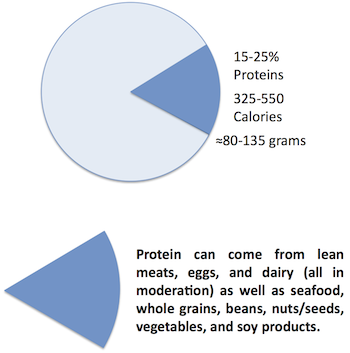Protein is one of the three primary macronutrients needed by the body (fats and carbohydrates being the other two). They are peptides made up of small building blocks called amino acids. During digestion, protein breaks down into its amino acid components. Then, these amino acids are absorbed by the intestines and used by the body to maintain, repair, and build tissues, including muscles. Stressing a muscle through daily activity and exercise breaks down its muscle fibers, which then must be repaired. In order for repair to take place, the body must have all the amino acids required to synthesize muscle proteins. Since the body does not store amino acids as reserves, proper daily protein intake is essential.

There are twenty amino acids required by the body for muscle synthesis. Of these twenty amino acids, the body can produce twelve, while the other eight must come from dietary intake. These eight amino acids are known as essential amino acids because they are essential in the diet. Therefore, it is important to regularly consume a variety of foods that provide these eight essential amino acids.
What is Protein: Types of Protein
-
Animal Protein Sources
There are two distinct food sources that provide protein: animal sources and non-animal sources. Animal sources, such as meat, dairy, and eggs, are generally complete. Being complete means they provide all necessary essential amino acids. While animal sources are complete, this type should be consumed in moderation because they typically have higher levels of saturated fats and cholesterol.
-
Non-Animal Protein Sources
Non-animal sources generally provide inadequate amounts of one or more essential amino acids and therefore are called incomplete. Nevertheless, there are non-animal food sources, including quinoa and soybeans, which provide a complete profile of amino acids. Additionally, combining two or more non-animal sources (like rice and beans) can be used to provide a complete source.
A well-balanced diet incorporating grains, beans, nuts, seeds, and vegetables can easily provide adequate protein and all the essential amino acids.
What is Protein: Protein Sources List
The following protein sources list provides the most common animal and non-animal protein sources. For a more comprehensive breakdown of this table, see EMG’s High Protein Foods List.
|
|
What is Protein: Caloric Breakdown
Approximately, 15 to 25% of your diet should come from protein. Based on a 2200 calorie diet, this percentage equates to anywhere between 80 to 135 grams or 325 to 550 calories based on a 2200 calorie diet. Protein can come from lean meats, eggs, dairy (all in moderation) as well as seafood, whole grains, beans, nuts/seeds, vegetables and unprocessed soy products like soybeans or tofu. Protein slows the digestion of food, so eating a small amount with every meal keeps you feeling fuller longer. This feeling of fullness will reduce urges to overeat. Additionally, adding a small amount to your pre-workout and post-workout meal helps to speed amino acid delivery to recovering muscles.
EMG’s Nutrition Homepage: How to Eat Healthy
External Resources: MyPlate.gov: What is Protein





